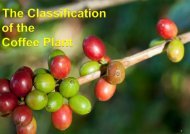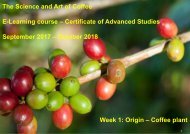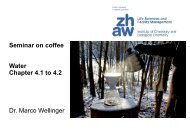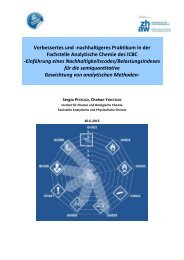Create successful ePaper yourself
Turn your PDF publications into a flip-book with our unique Google optimized e-Paper software.
Maragogipe: A mutant <strong>of</strong> Typica, first discovered near Maragogipe, Bahia, Brazil in 1870. The special<br />
characteristic <strong>of</strong> this variety is <strong>the</strong> production <strong>of</strong> large cherries and seeds, compared to Typica. The<br />
mutation is due to a single dominant gene, which acts not only on <strong>the</strong> size <strong>of</strong> <strong>the</strong> fruit, but also results in<br />
longer internodes and larger leaf size. Due to its relatively low yield, it has not been introduced to Brazil. But<br />
it is still grown in Nicaragua, Guatemala and Mexico due to its high cup quality.<br />
Pacas: A dwarf mutation <strong>of</strong> Bourbon discovered in 1949 on a farm owned by <strong>the</strong> Pacas in <strong>the</strong> Santa Ana<br />
region <strong>of</strong> El Salvador, where it is still grown today accounting for 25% <strong>of</strong> <strong>the</strong> country's c<strong>of</strong>fee production. In<br />
1960, <strong>the</strong> Salvadoran Institute for C<strong>of</strong>fee Research began a program <strong>of</strong> pedigree selection (selection <strong>of</strong><br />
individual <strong>plant</strong>s through successive generations) for Pacas.<br />
Pacas is similar to Caturra from Brazil and Villa Sarchi in Costa Rica, where a single-gene mutation<br />
resulted in smaller growth, also called “dwarfism’. Due to its smaller size, this variety has been <strong>plant</strong>ed at<br />
higher densities to increase <strong>the</strong> total production/area on a farm. It performs well at high elevations and has<br />
good yields. lt is known to be susceptible to all main diseases and pests.<br />
Pacamara: A cross between Maragogype and Pacas developed in El Salvador. Similarly to Pacas, it is<br />
known to be susceptible to all main diseases and pests. Pacamara was released by <strong>the</strong> Salvadoran<br />
Institute <strong>of</strong> C<strong>of</strong>fee Research in 1984. Due to incomplete pedigree selection, this variety is genetically<br />
unstable and 10-12% <strong>of</strong> <strong>plant</strong>s in a <strong>plant</strong>ation revert to Pacas (when <strong>plant</strong>ed as seeds).<br />
Maracaturra: Similar to Pacamara, where Caturra was crossed with Maragogipe, e.g. grown in Guatemala.<br />
45








